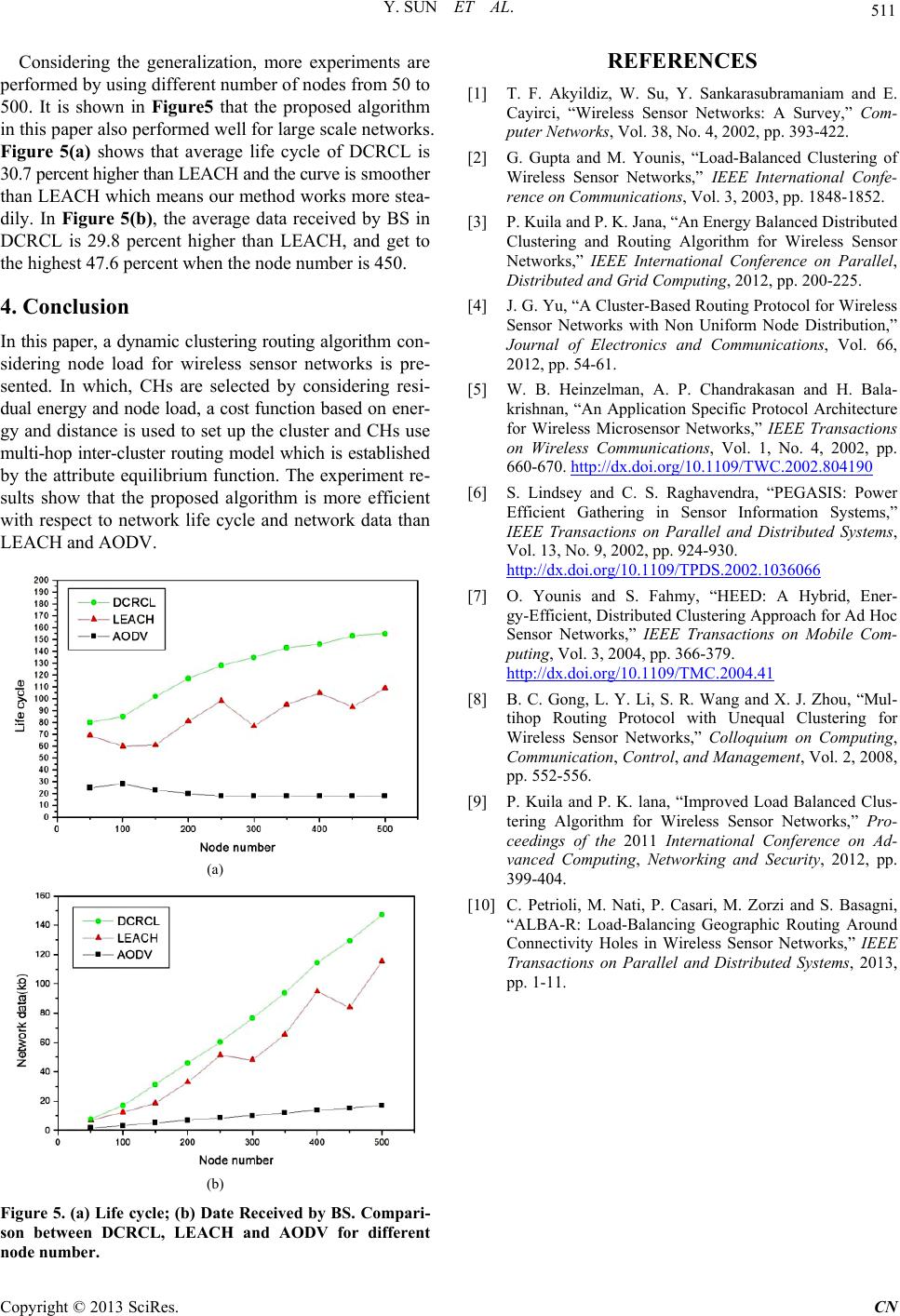
Y. SUN ET AL.
Copyright © 2013 SciRes. CN
Considering the generalization, more experiments are
performed by using different number of nodes from 50 to
500. It is shown in Figure5 that the proposed algorithm
in this paper also performed well for large scale networks.
Figure 5(a) shows that average life cycle of DCRCL is
30.7 percent higher than LEACH and the curve is smoother
than LEACH which means our method works more stea-
dily. In Figure 5(b), the average data received by BS in
DCRCL is 29.8 percent higher than LEACH, and get to
the highest 47.6 percent when the node number is 450.
4. Conclusion
In this paper, a dynamic clustering routing algorithm con-
sidering node load for wireless sensor networks is pre-
sented. In which, CHs are selected by considering resi-
dual energy and node load, a cost function based on ener-
gy and distance is used to set up the cluster and CHs use
multi-hop inter-cluster routing model which is established
by the attribute equilibrium function. The experiment re-
sults show that the proposed algorithm is more efficient
with respect to network life cycle and network data than
LEACH and AODV.
(a)
(b)
Figure 5. (a) Life cycle; (b) Date Received by BS. Compari-
son between DCRCL, LEACH and AODV for different
node number.
REFERENCES
[1] T. F. Akyildiz, W. Su, Y. Sankarasubramaniam and E.
Cayirci, “Wireless Sensor Networks: A Survey,” Com-
puter Networks, Vol. 38, No. 4, 2002, pp. 393-422.
[2] G. Gupta and M. Younis, “Load-Balanced Clustering of
Wireless Sensor Networks,” IEEE International Confe-
rence on Communications, Vol. 3, 2003, pp. 1848-1852.
[3] P. Kuila and P. K. Jana, “An Energy Balanced Distributed
Clustering and Routing Algorithm for Wireless Sensor
Networks,” IEEE International Conference on Parallel,
Distributed and Grid Computing, 2012, pp. 200-225.
[4] J. G. Yu, “A Cluster-Based Routing Protocol for Wireless
Sensor Networks with Non Uniform Node Distribution,”
Journal of Electronics and Communications, Vol. 66,
2012, pp. 54-61.
[5] W. B. Heinzelman, A. P. Chandrakasan and H. Bala-
krishnan, “An Application Specific Protocol Architecture
for Wireless Microsensor Networks,” IEEE Transactions
on Wireless Communications, Vol. 1, No. 4, 2002, pp.
660-670. http://dx.doi.org/10.1109/TWC.2002.804190
[6] S. Lindsey and C. S. Raghavendra, “PEGASIS: Power
Efficient Gathering in Sensor Information Systems,”
IEEE Transactions on Parallel and Distributed Systems,
Vol. 13, No. 9, 2002, pp. 924-930.
http://dx.doi.org/10.1109/TPDS.2002.1036066
[7] O. Younis and S. Fahmy, “HEED: A Hybrid, Ener-
gy-Efficient, Distributed Clustering Approach for Ad Hoc
Sensor Networks,” IEEE Transactions on Mobile Com-
puting, Vol. 3, 2004, pp. 366-379.
http://dx.doi.org/10.1109/TMC.2004.41
[8] B. C. Gong, L. Y. Li, S. R. Wang and X. J. Zhou, “Mul-
tihop Routing Protocol with Unequal Clustering for
Wireless Sensor Networks,” Colloquium on Computing,
Communication, Cont rol, and Management, Vol. 2, 2008,
pp. 552-556.
[9] P. Kuila and P. K. lana, “Improved Load Balanced Clus-
tering Algorithm for Wireless Sensor Networks,” Pro-
ceedings of the 2011 International Conference on Ad-
vanced Computing, Networking and Security, 2012, pp.
399-404.
[10] C. Petrioli, M. Nati, P. Casari, M. Zorzi and S. Basagni,
“ALBA-R: Load-Balancing Geographic Routing Around
Connectivity Holes in Wireless Sensor Networks,” IEEE
Transactions on Parallel and Distributed Systems, 2013,
pp. 1-11.